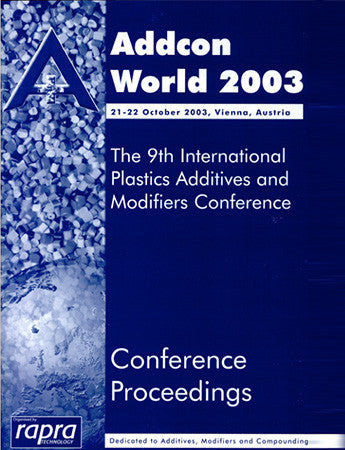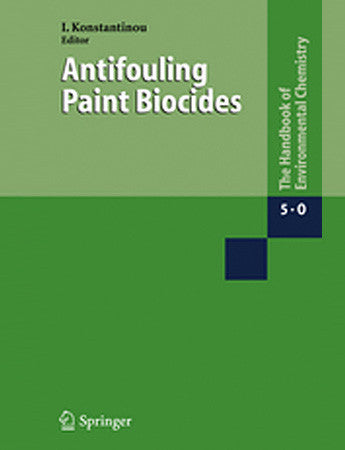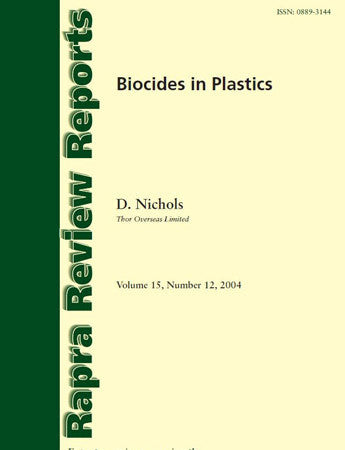Blowing Agents and Foaming Processes 2010
The 12th international Blowing Agents & Foaming Processes conference was developed to once again showcase the latest academic and industrial research shaping the future for so many industry applications.
Aside from the industries with a long-established connection to polymeric foams, a growing market is being driven by the current economic climate. End users are now sourcing innovative ways to keep costs down, identifying new materials, sources and material alternatives. Foamed substrates often represent cost effective alternatives with the dual benefits of saving material and reducing weight - the latter minimising shipping and other related expenses. As a result, new applications have been made commercially viable by the ongoing improvements in the mechanical performance of foamed materials.
These proceedings cover all the presentations from the conference which include developments in chemical and physical foaming, new applications, novel processes, nano and standard substrates, particle foams as well as the industry's response to environmental legislation.
Aside from the industries with a long-established connection to polymeric foams, a growing market is being driven by the current economic climate. End users are now sourcing innovative ways to keep costs down, identifying new materials, sources and material alternatives. Foamed substrates often represent cost effective alternatives with the dual benefits of saving material and reducing weight - the latter minimising shipping and other related expenses. As a result, new applications have been made commercially viable by the ongoing improvements in the mechanical performance of foamed materials.
These proceedings cover all the presentations from the conference which include developments in chemical and physical foaming, new applications, novel processes, nano and standard substrates, particle foams as well as the industry's response to environmental legislation.
Session 1: Blowing Agents and Blowing Gases
Paper 1 A novel procedure to analyse the foamability of thermoplastic forms using in-situ optical expandometry and X-ray radioscopy
Dr Eusebio Solórzano Quijano, Prof M A Rodriguez-Perez, J Pinto & J A de Saja, University of Valladolid, Spain and F Garcia-Moreno, Institute of Applied Materials, Germany
Paper 2 HFO-1234ze(E) and HBA-2: Advancements in low GWP blowing agents
J M Bowman, PE, Honeywell International, USA & Mary Bogan, Honeywell International, UK
Paper 3 Foaming selected thermoplastics under microwave irradiation
Dr Aleksander Prociak, T Sterzyñski, D Bogdal, S Michaowski & D Safian, University of Cracow, Poland
Paper 4 The supercritical state paradigm in thermoplastic foaming
Richard Gendron, Michel F Champagne, Jacques Tatibouët & Hongbo Li, Industrial Materials Institute, National Research Council of Canada, Canada
Paper 5 Further development of GWP foam expansion agent with improved insulating performance vs commercially available options today
Gary Loh, Joseph A Creazzo & Mark L Robin, DuPont Company, USA
Paper 6 Investigation of new low GWP blowing agents for rigid polyurethane foams
Laurent Abbas, Arkema, France & Ben Chen, Joseph Costa & Philippe Bonnet, Arkema, USA
Session 2: Injection Moulding Efforts
Paper 7 Case Study: solution with structural foam
Brian Read, Horizon Plastics International Inc, Canada +++ paper unavailable +++
Paper 8 Structural foam compared to other injection moulding processes
Helmut Eckardt, Wittmann Battenfeld GmbH & Co KG, Germany
Paper 9 Using in mold pressure and temperature sensors to monitor the microcellular foaming process
Levi Kishbaugh, Trexel GmbH, Germany & Mark Berry, PPD Tech LLC, USA
Paper 10 Possibilities of microcellular injection moulding with polycarbonate
Dipl-Ing Martin Rohleder, Prof A K Bledzki & Dr H Kirschling,Universität Kassel, Germany
Session 3: Extrusion New Aspects and Results
Paper 11 Physical foaming line for standard and high performance plastics
Joachim Meyke & Matthias Reimker, KraussMaffei Berstorff GmbH, Germany
Paper 12 Investigation of the corrugation in foam sheet extrusion
Dipl Ing Tilo Hildebrand & Prof Dr Ing E h Walter Michaeli, IKV Institute for Plastics Processing at RWTH Aachen University, Germany
Paper 13 The innovation potential of polymer foams
Holger Ruckdäschel, Eric Wassner, Jan Sandler & Klaus Hahn, BASF, Germany
Paper 14 Blowing agent emission from styrofoam extruded polystyrene foams –
A simplified model to estimate the residual blowing agent
Dr Chau V Vo & Friedhelm Bunge, DOW Europe GmbH, Germany & Simon P Lee, Dow Chemical, USA
Paper 15 Retrofitting conventional extrusion lines for physical foaming
Christian Schlummer & Frank Neubauer, Sulzer Chemtech Ltd, Switzerland
Paper 16 Improving the foaming behaviour of linear polypropylene-based TPO by introducing nanoclay
Prof Chul Park & Dr Wentao Zhai, University of Toronto, Canada
Session 4: Special Processes and Techniques
Paper 17 Polyethylene foams produced under a temperature gradient with Expancel® Microspheres and blends thereof
Prof Denis Rodrigue, Jiaolian Yao & Mohamad Reza Barzegari, Université Laval, Canada
Paper 18 Foaming of polypropylene by using both chemical and physical blowing agents – A comparative study of the structure and physical properties
Cristina Saiz Arroyo, Prof MA Rodriguez-Perez & J A de Saja, University of Valladolid & M Antunes & J I Velasco, Universitat Politècnica de Catalunya, Spain
Paper 19 Flexible elastomeric foam insulations – a permanent challenge for the foam manufacturer
Dr Jürgen Weidinger, Armacell International Holding GmbH, Germany
Session 5: Particle Foams
Paper 20
Expanded Polypropylene, a low density manufacturing and applications
Bert Suffis,, JSP, France +++paper unavailable +++
Paper 21 Correlations between density and bead size on the dynamic mechanical behaviour of polystyrene bead foams
Dipl-Chem Marieluise Stumpf, Frank Fischer & Volker Altstädt, Universität Bayreuth, Germany
Session 6: Detailed Efforts on Nano Techniques and Ageing
Paper 22 Poly(styrene-co-acrylonitrile) foaming with supercritical CO2 : Influence of nanoclay on the foam morphology and flammability
Laetitia Urbanczyk, Serge Bourbigot, Christophe Detrembleur, Christine Jérôme, Phong Minh Tran & Michael Alexandre, University of Liège, Belgium
Paper 23 Myths and facts surrounding long term aging of foam insulation
John Murphy, Foam Supplies, Inc, USA
Paper 1 A novel procedure to analyse the foamability of thermoplastic forms using in-situ optical expandometry and X-ray radioscopy
Dr Eusebio Solórzano Quijano, Prof M A Rodriguez-Perez, J Pinto & J A de Saja, University of Valladolid, Spain and F Garcia-Moreno, Institute of Applied Materials, Germany
Paper 2 HFO-1234ze(E) and HBA-2: Advancements in low GWP blowing agents
J M Bowman, PE, Honeywell International, USA & Mary Bogan, Honeywell International, UK
Paper 3 Foaming selected thermoplastics under microwave irradiation
Dr Aleksander Prociak, T Sterzyñski, D Bogdal, S Michaowski & D Safian, University of Cracow, Poland
Paper 4 The supercritical state paradigm in thermoplastic foaming
Richard Gendron, Michel F Champagne, Jacques Tatibouët & Hongbo Li, Industrial Materials Institute, National Research Council of Canada, Canada
Paper 5 Further development of GWP foam expansion agent with improved insulating performance vs commercially available options today
Gary Loh, Joseph A Creazzo & Mark L Robin, DuPont Company, USA
Paper 6 Investigation of new low GWP blowing agents for rigid polyurethane foams
Laurent Abbas, Arkema, France & Ben Chen, Joseph Costa & Philippe Bonnet, Arkema, USA
Session 2: Injection Moulding Efforts
Paper 7 Case Study: solution with structural foam
Brian Read, Horizon Plastics International Inc, Canada +++ paper unavailable +++
Paper 8 Structural foam compared to other injection moulding processes
Helmut Eckardt, Wittmann Battenfeld GmbH & Co KG, Germany
Paper 9 Using in mold pressure and temperature sensors to monitor the microcellular foaming process
Levi Kishbaugh, Trexel GmbH, Germany & Mark Berry, PPD Tech LLC, USA
Paper 10 Possibilities of microcellular injection moulding with polycarbonate
Dipl-Ing Martin Rohleder, Prof A K Bledzki & Dr H Kirschling,Universität Kassel, Germany
Session 3: Extrusion New Aspects and Results
Paper 11 Physical foaming line for standard and high performance plastics
Joachim Meyke & Matthias Reimker, KraussMaffei Berstorff GmbH, Germany
Paper 12 Investigation of the corrugation in foam sheet extrusion
Dipl Ing Tilo Hildebrand & Prof Dr Ing E h Walter Michaeli, IKV Institute for Plastics Processing at RWTH Aachen University, Germany
Paper 13 The innovation potential of polymer foams
Holger Ruckdäschel, Eric Wassner, Jan Sandler & Klaus Hahn, BASF, Germany
Paper 14 Blowing agent emission from styrofoam extruded polystyrene foams –
A simplified model to estimate the residual blowing agent
Dr Chau V Vo & Friedhelm Bunge, DOW Europe GmbH, Germany & Simon P Lee, Dow Chemical, USA
Paper 15 Retrofitting conventional extrusion lines for physical foaming
Christian Schlummer & Frank Neubauer, Sulzer Chemtech Ltd, Switzerland
Paper 16 Improving the foaming behaviour of linear polypropylene-based TPO by introducing nanoclay
Prof Chul Park & Dr Wentao Zhai, University of Toronto, Canada
Session 4: Special Processes and Techniques
Paper 17 Polyethylene foams produced under a temperature gradient with Expancel® Microspheres and blends thereof
Prof Denis Rodrigue, Jiaolian Yao & Mohamad Reza Barzegari, Université Laval, Canada
Paper 18 Foaming of polypropylene by using both chemical and physical blowing agents – A comparative study of the structure and physical properties
Cristina Saiz Arroyo, Prof MA Rodriguez-Perez & J A de Saja, University of Valladolid & M Antunes & J I Velasco, Universitat Politècnica de Catalunya, Spain
Paper 19 Flexible elastomeric foam insulations – a permanent challenge for the foam manufacturer
Dr Jürgen Weidinger, Armacell International Holding GmbH, Germany
Session 5: Particle Foams
Paper 20
Expanded Polypropylene, a low density manufacturing and applications
Bert Suffis,, JSP, France +++paper unavailable +++
Paper 21 Correlations between density and bead size on the dynamic mechanical behaviour of polystyrene bead foams
Dipl-Chem Marieluise Stumpf, Frank Fischer & Volker Altstädt, Universität Bayreuth, Germany
Session 6: Detailed Efforts on Nano Techniques and Ageing
Paper 22 Poly(styrene-co-acrylonitrile) foaming with supercritical CO2 : Influence of nanoclay on the foam morphology and flammability
Laetitia Urbanczyk, Serge Bourbigot, Christophe Detrembleur, Christine Jérôme, Phong Minh Tran & Michael Alexandre, University of Liège, Belgium
Paper 23 Myths and facts surrounding long term aging of foam insulation
John Murphy, Foam Supplies, Inc, USA




